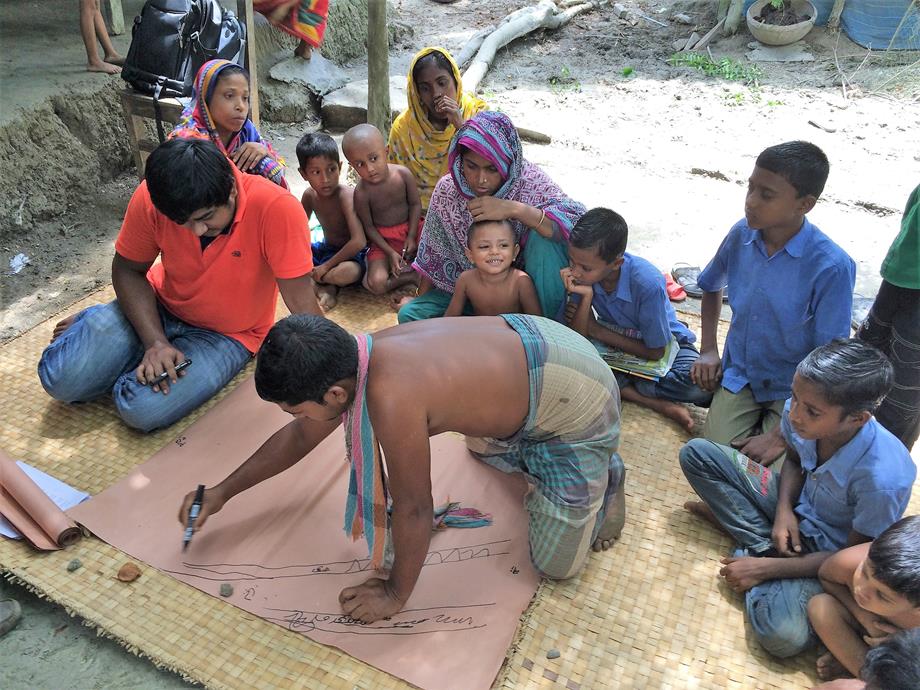Bhasa Project
Case Study
Country: Bangladesh
Author: Fazlul Kader
Organisation: Centre for Injury Prevention and Research
Aims
To understand the context and social impact of drowning and water related disasters in community settings in Bangladesh, using qualitative research methods.
Background
In 2003, results from the Bangladesh Health and Injury Survey showed drowning to have a significant impact on the health and wellbeing of the Bangladeshi population. Here, drowning was identified as the single leading cause of death for children aged 1 to 17 years. Despite this, little is known about why drowning is so common, what impact drowning has on individuals, families and communities, or what appropriate and effective approaches could be implemented for its prevention.
Methodology
Initial stages of the Bhasa Project aimed to investigate the burden and impact of drowning in Bangladesh. Qualitative aspects of the study involved conducting in-depth interviews, focus group discussions and observations. A broad range of stakeholders were involved:
Community stakeholders
Included household heads, parents, children, community leaders, individuals involved in disaster preparedness and relief, the users and operators of water transport vessels, and fishermen. Research questions investigated regular participant interactions with water, their perceptions of drowning, and probed for ideas on appropriate community-level drowning reduction interventions.
National stakeholders
Included government representatives from the Department of Disaster Management, Department of Fisheries, Ministry of Health, Ministry of Education, Bangladesh Inland Water Transport Authority, Launch Owners Association of Bangladesh, high-level officials from the Bangladesh Ansar, the fire brigade, coast guard, and local NGOs working in drowning prevention and disaster management. Research question investigated the barriers and facilitators to implementing polices on safe water practices, balancing competing priorities and resource allocation, reward systems for health and disaster management systems, and the delivery of drowning reduction interventions.
Global stakeholders
Included representatives from bilateral and multilateral organisations, such as the World Health Organisation, the Royal National Lifeboat Institute, and the Royal Life Saving Society. Research questions investigated how national and regional health systems and policy frameworks are influenced by the global context.
References
Barisal Project factsheet (PDF 4,538KB)Further information/resources
‘Superstition’ prevents action against children drowning in Bangladesh
“[Drowning] is an accident, and accidents are accidents. They cannot be prevented. Is there anything we can do? No! Human beings cannot to do anything to prevent drowning, this is Allah’s [Gods] will, if Allah wishes, then He can save you from drowning.”
Outcomes
A total of 102 in-depth interviews, 25 focus group discussions and 22 observations were conducted through the project. Some key findings include:
- Drowning was viewed as a natural phenomenon and was not considered to be preventable by many community stakeholders. Drowning was frequently conceptualized as an accident, Gods wish, or to be caused by an evil spirit.
- Certain occupational groups, such as fishermen and water transport providers, are at a high risk of drowning due to their high exposure to water and lack of awareness on water safety.
- Community members perceived the main causes of child drowning to be the close proximity of households to waterbodies, the presence of many unfenced waterbodies in community settings, a lack of adult supervision for children and a lack of swimming ability among both adults and children.
- Once a child is rescued from water following a drowning event, community members reported the use of traditional post drowning treatments. These included spinning the child’s body and applying sand, salt and clay utensils to the body to draw out ingested water.

“We [fishermen] do not want to go fishing in bad weather, but we have to go [as per] the words of our owner. ”
Challenges
- Due to the remoteness of the study areas, participant recruitment to meet selection criteria was difficult. It was particularly challenging to identify population subgroups in specific geographic areas (for example, identifying fishermen in inland, riverine and coastal areas).
- At times, it was difficult to understand the local dialects used at different study sites.
- Local conflicts were encountered during participant recruitment and data collection.
- Some participants expected aid and money from the study team.
- It was difficult to maintain the data collection schedule due to frequent bad weather.
Lessons learned
- Community meetings should be held at each study site prior to data collection to clarify that no relief, assistance or money will be provided to participants.
- Consider seasonality prior to data collection. Some participant subgroups were busy during certain times of the year (for example, fishermen) and were unavailable for data collection.
Replicability
The question guides and observation guides used for the Bhasa project were developed specifically for the local context. Rapid ethnography was used in early project stages to scope the study area, identifying priority areas to investigate further. A similar approach should be taken to the development of study tools in different contexts and settings.
Step 1
Assess the situation